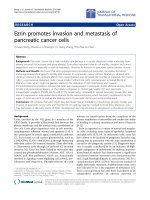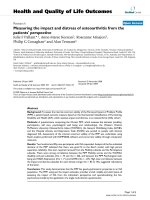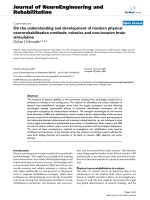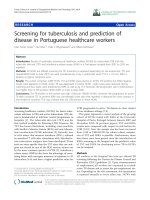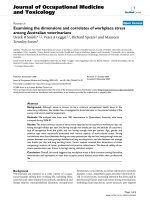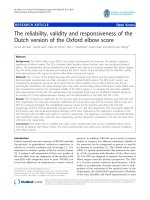Báo cáo hóa học: " Arc Discharge Synthesis and Photoluminescence of 3D Feather-like AlN Nanostructures" pot
Bạn đang xem bản rút gọn của tài liệu. Xem và tải ngay bản đầy đủ của tài liệu tại đây (655.42 KB, 6 trang )
NANO EXPRESS Open Access
Arc Discharge Synthesis and Photoluminescence
of 3D Feather-like AlN Nanostructures
SL Yang
1,2*
, RS Gao
1
, PL Niu
1
, ZY Zou
3
,RHYu
1,3
Abstract
A complex three-dimensional (3D) feather-like AlN nanostructure was synthesized by a direct reaction of high-
purity Al granules with nitrogen using an arc discharge method. By adjusting the discharge time, a coral-like
nanostructure, which evolved from the feather-like nanostructure, has also been observed. The novel 3D feather-
like AlN nanostructure has a hierarchical dendritic structure, which means that the angle between the trunk stem
and its branch is always about 30° in any part of the structure. The fine branches on the surface of the feather-like
nanostructure have shown a uniform fish scale shape, which are about 100 nm long, 10 nm thick and several tens
of nanometers in width. An alternate growth model has been proposed to explain the novel nanostructure. The
spectrum of the feather-like products shows a strong blue emission band centered at 438 nm (2.84 eV), which
indicates their potential application as blue light-emitting diodes.
Introduction
In recent years, the complex three-dimensional (3D)
semiconductor nanostructures have become a research
focus, which are considered as basic units of future
nano-devices and ideal specimens for the fundamental
physical research in nanoscale. Moreover, understanding
the formation mechan ism of t hese complex 3D nanos-
tructures should lead to advances in nano-fabrication.
AlN with a wide direct band gap (6.2 eV) is a quite
important III–V semiconductor, which has some excel-
lent physical and chemical properties, such as h igh heat
conductivity, high hardness, high chemical stability and
a similar thermal expan sion with Si. In the past decade,
AlN nanostructures have aroused much interest for pro-
mising application in field-emission (FE) and visible
light emission. AlN nanowires and array [1-4], nanorod
array [5-7], nanotips and array [8-11], nanobelts [12,13]
and comb-like structures [14], which are classified as
low-dimension nanostructures, have been synthesized by
different methods. Recently, some complex 3D AlN
nanostructures, called urchin-like [15], sixfold symmetry
[16,17], pine-shaped [18] and flowerlike [9] nanostruc-
tures, have been reported. The formation of the complex
AlN nanostructures was generally considered as a
vapor–solid (VS) process. To the best of our knowledge,
there has been no report on the synthesis of high-
quality complex 3D feather-like AlN nanostructures.
In this paper, a 3D feather- like AlN nanostructure has
been prepared by a direct arc discharge method [5,9,15]
without any catalyst or template, and an alternating
growth mechanism is introduced to understand the
nov el na nostruc ture. By extending the discharge time, a
coral-like nanostructure, which evolv ed from the
feather-like nanostructure, has also been prepared. The
spectrum of photoluminescence reveals that th e feather-
like AlN nanostructure has an excellent blue emission
band centered at 438 nm (2.84 eV), indicating potential
applications in optoelectronic nano-devices.
Experimental Approach
High-purity Al granules (99.99%) were arc melted to a
pure Al ingot in a pure argon atmosphere. Before arc
discharge, the chamber was evacuated to 5 × 10
-3
Pa
and flushed with pure Ar two times to remove oxygen.
Then, a mixture of pure nitrogen and Ar was flushed in
as reaction gas with a pressure of 10
5
Pa. The ratio of
partial pressure of N
2
used in experiments was 50%.
The tip of a tungsten cathode was kept about 10 mm
above the Al ingot during the arc discharge. The dis-
charge current and time were considered as two key
parameters, which were adjusted in the experiments in
order to investigate the growth of the products. When
* Correspondence:
1
Department of Materials Science and Engineering, Tsinghua University,
Beijing 100084, People’s Republic of China
Full list of author information is available at the end of the article
Yang et al. Nanoscale Res Lett 2011, 6:12
/>© 2010 Yang et al. This is an Open Access article distributed under the terms of the Crea tive Commons Attribution License
( ses/by/2.0), which permits unres tricted use, distribution, and reproduction in any medium,
provided the original work is prope rly cited.
the discharge began, a pit would appear on the ingot
immediately. After arc discharge, some gray products in
the pit were collected for later characterization. The
phase composition and chemical composition of the
samples have been detected by X-ray diffraction (XRD;
D8-ADVANCE) and energy-dispersive X-ray spectro-
scopy (EDS), respectively. The morphology and crystal-
line structure of the products were characterized by
field-emission scanning electron microscopy (FE-SEM;
Gemini LEO-1530) and transmission electron micro-
scopy (TEM; JEOL JSM 2011). The photoluminescence
spectrums of the samples were measured at room tem-
perature using a spectrophotometer (PL, LS55, a Xe
lamp with 325-nm wavelength as the excitation light
source).
Results and Discussion
The arc discharge experiments have been carried out
with a series of current, from 100 to 200 A. Amazing
products had been prepared at 180 A, and the discharge
time was set at 30 and 60 s. The as-grown products pre-
paredbydifferentdischargetimehavealmostthesame
XRD pattern. Figure 1 shows a typical XRD pattern of
the products. All the peaks in the pattern could be
indexed to a wurtzite-structure AlN (h-AlN) crystalline
structure with lattice constants of a = b = 0.3111 nm
and c = 0.4979 nm (JCPDS: 25-1133), which shows that
pure wurtzite-AlN can be prepared by arc discharge.
A nice coral-like microstructure was prepared using 180
A discharge current for 60 s, as illustrated in Figure 2. The
as-grown AlN “coral” has a clear dendritic structure. The
length of the trunk is about several tens of micrometers,
and diameters are less than 10 μm. Figure 2c shows the
fine structure of the coral that has a smooth melt-out
surface. The small branches, shown in Figure 2c, have a
length of several micrometers, and the diameter is about
several hundreds of nanometer s. The m elt-out surface of
the small branches means that the temperature was too
high that AlN crystals began to melt.
When keepi ng the current 180 A and decreasing time
to 30 s, an amazing self-assembled feather-like nano-
structure was prepared as shown in Figure 3. The AlN
“feathers” are considered as a hierarchical dendritic
nanostructure. Figure 3a is an overall SEM image of
feather-like nanostructures with sizes rangi ng from 2 to
20 μm, which are smaller than the coral-like products.
Figure 3b and 3c are typical SEM images of complete
feathers in different scales, both of which show a den-
dritic structure. It implies that the feather-like nano-
structure will be transformed to coral-like products by
extending the disch arge time. Feathers of different sizes
observed in the experiments might be at different
growth stages. Figure 3d and 3e are high-magnification
SEM images, which show more details of feather-like
nanostructure. The surface of the feather has a fish scale
structure. The scale-shaped fine branches are almost
uniform, which are about 100 nm long, 10 nm thick and
several tens of nanometers in width. However, there
might be more fine structures in the “scale” as shown in
Figure 3e. High-resolution TEM was employed to inves -
tigate the novel nanostructure,butitwasverydifficult
to get a clear HRTEM image and the corresponding
selected area electron diffraction (SAED) pattern of the
special nanostructures for the b ranches cross over each
other in 3D space. Figure 4a and 4b are the most clear-
cut TEM images we got in the experiments, which
supply a better view of the internal details of the
feath er-like nanostructure. It appears that the feather is
constituted of trunk and oblique branches. The trunk is
nearly straight, and the angle between the trunk and its
branches is about 30°, which is consistent with the SEM
results (a marked in Figure 3c, d). The fine branches
with a thickness less than 10 nm are separated by void.
EDS analyses were carried out on numerous samples
and showed that the ratio between Al and N atoms is
nearly 1, which ensure that the composition of the
feathe r nanostructure is AlN. Figure 4c is a typical EDS
pattern of the TEM samples, and very low levels of oxy-
gen have also been detected in our experiments.
As far as we know, there are very few reports about
feather-li ke nanostructure. Similar “ leaf-like” or
“dendrite-like” structures have been prepare d by
MOCVD [19], CVD [20] and magnetron sputtering
[21,22] in TiO
2
, W and FeSiAl(Ti/Ta)(O)N thin films.
Brien [23] has done a pioneering work o n the growth
mechanism of the feather-like nanostructure in AlN
thin film prepared by reaction sputtering, which con-
firmed that the trunk was along the [0001] direction
Figure 1 XRD pattern of the products with all peaks indexed
to wurtzite-structure AlN (h-AlN).
Yang et al. Nanoscale Res Lett 2011, 6:12
/>Page 2 of 6
Figure 2 Typical SEM images of the coral-like AlN nanostructures: a a low-magnification SEM image of high-dens ity as-grown coral-
like products; b shows a clear dendritic structure; c a close view of fine branches with melt-out surface.
Figure 3 SEM images of the feather-like AlN nanostructures: a a low-magnification SEM image; b, c typical SEM images of a complete
feather-like AlN nanostructure; d, e high-magnification SEM images show a scale-shaped fine structure of the feather-like products.
The angle between the trunk and its branches (a) marked in (c) and (d) is about 30°.
Yang et al. Nanoscale Res Lett 2011, 6:12
/>Page 3 of 6
and the growth direction of oblique branches was per-
pendicular to the {10
1
3} of h-AIN. Therefore, the theo-
retical angle between the (0001) and (10
1
3) is 31.65°.
Our SEM and TEM images have revealed that the angle
between the trunk and its branches is about 30°, and the
XRD pattern (Figure 1) shows that both (0001) and
(10
1
3) have relatively strong peaks. However, feather-
like AlN nanostructure prepared by arc discharge is
more complex than that had been prepared in the film.
The complex 3D feather-like nanostructure has a hier-
archical structure, which seems that new small branches
with a certain orientation (still about 30°) will grow on
the oblique branches.
An alternate growth model has been proposed to
explain the novel nanostructure as illustrated in Figure 5.
The arc discharge reaction growth should be a VS pro-
cess. When arc discharge begins, activate Al and N
atoms will be continuously generated near the surface of
the Al ingot, and a pit will appear immediately as a mol-
ten pool. After intense reaction, a lot of AlN crystals
will nucleate on the inter surface of the pit. As the
(0001) plane of h-AlN is the most close-packed plane, a
growth along [0001] direction follows the principle of
minimum energy. Nevertheless, the growth is under the
control of thermodynamic and kinetic principles simul-
taneously. During arc discharge, the reaction tempera-
ture will be about 2,400–3,000 K and the pressure will
become above 1.3 × 10
5
Pa, which means that the
growth process is non-equilibrium and supersaturated.
Thus, some oblique growth ( perpendicular to the
{10
1
3} of h-AlN) will happen, which can supply more
growth space and high growth speed. Meanwhile,
growth along [0001] direction a ppears on the oblique
branches, which means that th e nanostructure is formed
by an alternate growth along two crystal directions. It
should be a balance of the crystal stability and growth
speed. The good symmetrical morphology of feather-like
nanostructures might originate from the symmetry of
the alternate growth model as shown in Figur e 5. The
outer branch tips had more chance collecting molecules,
Figure 4 a, b TEM images of the feather-like nanostructures;
c typical EDS pattern of the TEM samples.
Figure 5 A scheme o f the alternate growth mechanism.
n
1
is
the direction perpendicular to (10
1
3) and
n
0
is perpendicular to
(0001). The theoretical angle (a
1,2,3
) between the trunk and its
branches is 31.65°.
Yang et al. Nanoscale Res Lett 2011, 6:12
/>Page 4 of 6
so more fine structures (like fish scale) were found on
the surface, and void was generated by shadowing effect.
It should be emphasized that Figure 5 is a simplified 2D
diagram, whereas the real branches will grow in a 3D
space, which should lead to the complex 3D feat her-like
nanostructure. Nevertheless, a perfect explanation of the
3D feather-like AlN nanostructures still needs more
detailed and direct evidences.
Figure 6 shows room temperature photoluminescence of
AlN n anostructur es prepared in the exp eriments, and so me
commercial AlN powders (D50 = 0.5 μm, AlN > 99%,
O < 0.4%) were tested for comparison. The emission inten-
sities have been normalized by the blue emission peak of
the sample with feather-like nanostructures. The spectrum
of the feather-like products shows a strong blue emission
band centered at 438 nm (2.84 e V), whereas there is a lmost
no visible light emission gene rated from the commerci al
AlN powders. The emission intensity of the coral-like
products prepared by longer discharge time has shown
a remarkable decrease compared with feather-like
nanostructures.
Normally, AlN material has an energy band gap of
6.2 eV, and the band gap should increase when the size
of nanostructure decreased [24]. The observed intensive
blue emission is obviously not related to the direct band
gap transition ( larger than 6.2 eV), and it has been
attributed to the energy level generated by nitrogen defi-
ciency and oxygen impurities [4,8,12,25] in the wide
band gap. Generally, the defects are present at the
surface of nanomaterials. The feather-like AlN nano-
structures with fine surface structure have a higher sur-
face area to volume ratio than the coral- like products,
which results in a high level of surface defects. On the
other hand, when increasing the discharge time, more
completely reaction and higher growth temperature will
make fewer defects left, so a decrease in emission inten-
sity will be observed.
Conclusion
A complex three-dimensional (3D) feather-like AlN
nanostructure was synthesized by a direct reaction of
high-purity Al granules with nitrogen using an arc dis-
charge method. By adjusting the arc discharge time, a
3D coral-like AlN nanostructure has also been prepared,
which is considered as the evolution of 3D feather-like
products. The novel 3D feather-like AlN nanostructure
with a hierarchical dendritic structure has shown a good
symmetry, and an alternate growth model has been pro-
posed to explain the novel nanostructure. The spectrum
of the feather-like products shows a strong blue emis-
sion band centered at 438 nm (2.84 eV), which indicates
their potential application as blue light-emitting diodes.
Acknowledgements
This work is supported by National Science Foundation of China (50729101,
50525101 and 50771058).
Author details
1
Department of Materials Science and Engineering, Tsinghua University,
Beijing 100084, People’s Republic of China
2
Astronaut Center of China,
Beijing 100094, People’s Republic of China.
3
School of Materials Science and
Engineering, Beihang University, Beijing 100191, People’s Republic of China.
Received: 10 May 2010 Accepted: 5 August 2010
Published: 26 August 2010
References
1. Lv HM, Chen GD, Ye HG, Yan GJ: J Appl Phys 2007, 101.
2. Wu Q, Hu Z, Wang XZ, Lu YN, Huo KF, Deng SZ, Xu NS, Shen B, Zhang R,
Chen Y: J Mater Chem 2003, 13:2024-2027.
3. Zhao Q, Zhang HZ, Xu XY, Wang Z, Xu J, Yu DP, Li GH, Su FH: Appl Phys
Lett 2005, 86.
4. Xu CK, Xue L, Yin CR, Wang GH: Phys Status Solidi A—Appl Res 2003,
198:329-335.
5. Yang SL, Gao RS, Niu PL, Yu RH: Appl Phys A — Mater Sci Process 2009,
96:769-774.
6. Zheng J, Yang Y, Yu B, Song XB, Li XG: Acs Nano 2008, 2:134-142.
7. Yang J, Liu TW, Hsu CW, Chen LC, Chen KH, Chen CC: Nanotechnology
2006, 17:S321-S326.
8. Chen HT, Wu XL, Xiong X, Zhang WC, Xu LL, Zhu J, Chu PK: J Phys D—Appl
Phys 2008, 41.
9. Tang YB, Cong HT, Wang ZM, Cheng HM: Appl Phys Lett 2006, 89.
10. Tang YB, Cong HT, Chen ZG, Cheng HM: Appl Phys Lett 2005, 86.
11. Zhao Q, Xu J, Xu XY, Wang Z, Yu DP: Appl Phys Lett 2004, 85:5331-5333.
12. Tang YB, Cong HT, Li F, Cheng HM: Diamond Relat Mater 2007, 16:537-541.
13. Wu Q, Hu Z, Wang XZ, Chen Y, Lu YN: J Phys Chem B 2003, 107:9726-9729.
14. Yin LW, Bando Y, Zhu YC, Li MS, Li YB, Golberg D: Adv Mater 2005, 17:110.
15. Lei WW, Liu D, Zhang J, Zhu PW, Cui QL, Zou GT: Cryst Growth Des 2009,
9:1489-1493.
16. Zhang F, Wu Q, Wang XB, Liu N, Yang J, Hu YM, Yu LS, Wang XZ, Hu Z,
Zhu JM: J Phys Chem C 2009, 113:4053-4058.
17. Lei WW, Liu D, Zhu PW, Chen XH, Zhao Q, Wen GH, Cui QL, Zou GT: Appl
Phys Lett 2009, 95.
18. Lei WW, Liu D, Zhu PW, Wang QS, Liang G, Hao J, Chen XH, Cui QL,
Zou GT: J Phys Chem C 2008, 112:13353-13358.
19. Backman U, Auvinen A, Jokiniemi JK: Surf Coat Technol 2005, 192:81-87.
20. Goossens A, Maloney EL, Schoonman J: Chem Vap Deposition 1998,
4:109-114.
Figure 6 The photoluminescence spectrums of the feather-like,
coral-like products and commercial AlN powders measured at
room temperature. The emission intensities have been normalized
by the blue emission peak of the feather-like samples.
Yang et al. Nanoscale Res Lett 2011, 6:12
/>Page 5 of 6
21. Shen YG, Mai YW, Zhang QC, McKenzie DR, McFall WD, McBride WE: J Appl
Phys 2000, 87:177-187.
22. Hiramoto M, Matsukawa N, Sakakima H, Ichikawa Y, Ijima K: J Appl Phys
1998, 83:6655-6657.
23. Brien V, Miska P, Bolle B, Pigeat P: J Cryst Growth 2007, 307:245-252.
24. Guisbiers G, Buchaillot L: J Phys D—Appl Phys 2008, 41.
25. Cao YG, Chen XL, Lan YC, Li JY, Xu YP, Xu T, Liu QL, Liang JK: J Cryst Growth
2000, 213:198-202.
doi:10.1007/s11671-010-9745-4
Cite this article as: Yang et al.: Arc Discharge Synthesis and
Photoluminescence of 3D Feather-like AlN Nanostructures. Nanoscale
Res Lett 2011 6:12.
Submit your manuscript to a
journal and benefi t from:
7 Convenient online submission
7 Rigorous peer review
7 Immediate publication on acceptance
7 Open access: articles freely available online
7 High visibility within the fi eld
7 Retaining the copyright to your article
Submit your next manuscript at 7 springeropen.com
Yang et al. Nanoscale Res Lett 2011, 6:12
/>Page 6 of 6
